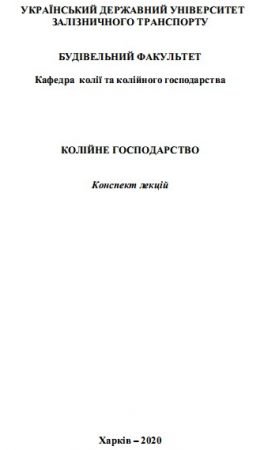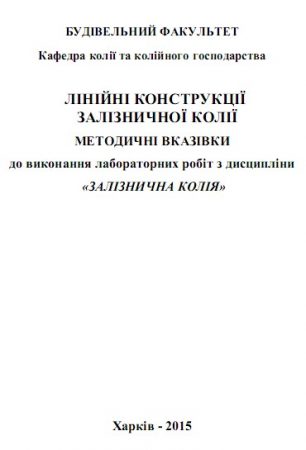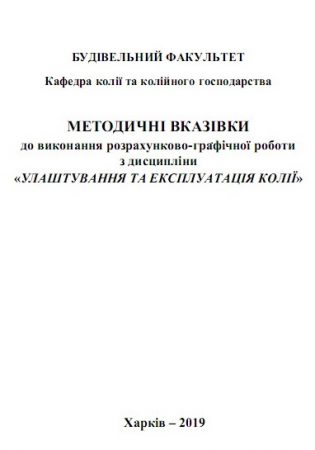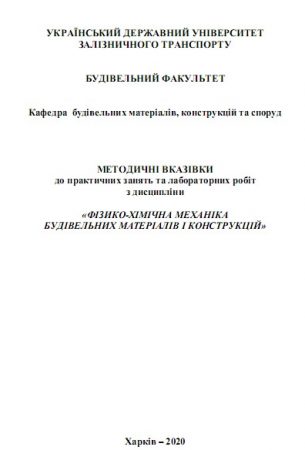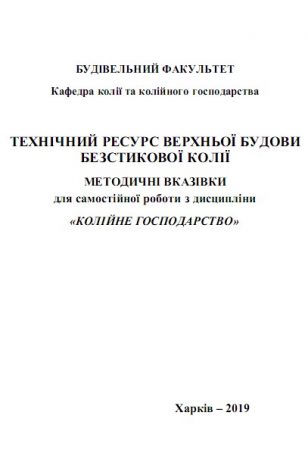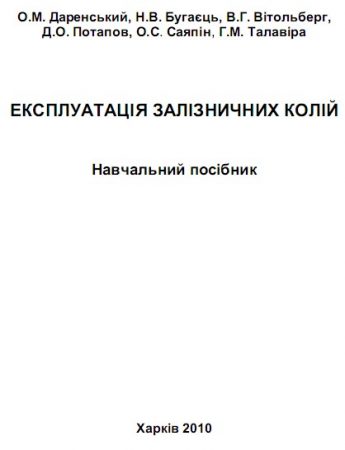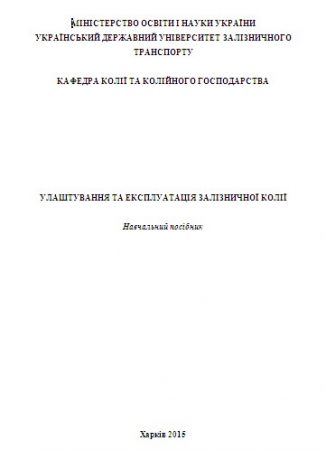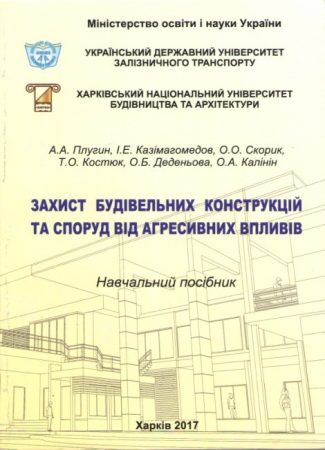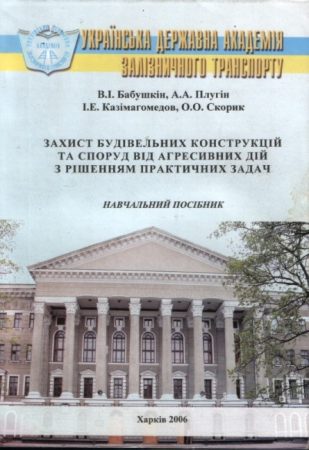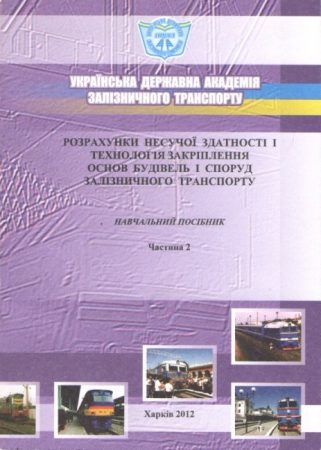Educational and methodical work of the department
Track facilities: a synopsis of lectures / A. M. Shtompel, M. G. Bugaets, A. S. Malyshevska, N. O. Murygina. – Kharkiv: UkrSURT, 2020. – 79 p.
The synopsis provides a description of the current state of railway track facilities, the basics of its management system, and also considers issues related to the planning and organization of railway track repairs. It is recommended for students of all forms of education studying the discipline “Railway facilities”.
Linear constructions of the railway track: O.M. Darenskyi, D.O. Potapov, V.G. Vitolberg, O.O. Ovchinnikov; department of track and track facilities. – Kharkiv: UkrSURT, 2015. – 33 p.
These methodological instructions are intended for better assimilation of lecture and practical material during the study of railway track construction from the discipline “Railway track”, students of the 4th year of the specialty “Railway structures and track facilities” perform laboratory work in the laboratory of the “Track and track facilities” department.
Arrangement and operation of track / compilers: O. A. Dudin, N. V. Bugaets; department of track and track facilities. – Kharkiv: UkrSURT, 2019. – 26 p.
Methodical instructions are a guide for performing calculation and graphic work in the discipline “Arrangement and operation of track”. It is recommended for full-time students of the specialty 275.02 “Transport technologies (on railway transport)”.
Physico-chemical mechanics of building materials and structures: Study guide in 2 parts / A. M. Plugin, L. V. Trikoz, A. A. Plugin. – Kharkiv: KharSART, 1999. – Part 1. – 111 p.; Part 2. – 134 p.
The main provisions of colloid chemistry and physico-chemical mechanics in relation to building materials and structures made of them are outlined. Taking into account these fundamental ideas, the basic properties of building materials, most widely – materials based on mineral and organic binders, mechanisms of various processes underlying the behavior of these materials and structures in operational conditions, new quantitative ideas about the nature of strength, deformability, destruction and durability of building materials and structures made of them are presented. The manual is intended for students studying in the educational programs of specialties 192 Construction and civil engineering, 273 Railway transport, as well as for graduate students, researchers and specialists working in this field of science and technology. Ill. 73, table 4, bibliography: 20 titles.
Physico-chemical mechanics of building materials and structures: A. A. Plugin, L. V. Trikoz, O. S. Borzyak; Department of Building Materials, Structures and Buildings. – Kharkiv: UkrDUZT, 2020. – 46 p.
The purpose of these methodological instructions is to provide students with auxiliary material for practical and/or laboratory work from the course “Physico-chemical mechanics of building materials and structures”. To increase independence in preparing and carrying out work, the instructions contain control questions for self-training. Methodical instructions are intended for students of specialties 192 “Construction and civil engineering” and 273 “Railway transport” of all forms of education, as well as other specialties of the corresponding areas.
Technical resource of the upper structure of the seamless track: methodological instructions for independent work in the discipline “Track facilities ” / compilers: A. M. Shtompel, A. S. Malyshevska, N. O. Murygina; department of track and track facilities. – Kharkiv: UkrSURT, 2019. – 40 p.
The methodological instructions consider issues related to the assessment of the technical resource of the structure of the top structure of the seamless track. It is recommended for students of all forms of education studying the discipline “Track facilities”.
Operation of railway tracks: a study guide / O. M. Darenskyi, N. V. Bugaets, V. G. Vitolberg and others. – Kharkiv: UkrSURT, 2010. – 169 p
In the study guide, the basics of track management, machineization and mechanization of track facilities, current track maintenance, types of track repairs, methods and means of work, planning and organization of track repairs, track repair technology, safety techniques during track work are considered. The study guide is recommended for full-time students of specialty 275.02 “Transport technologies (on railway transport)” and other technical and economic specialties of railway transport.
Arrangement and operation of a railway track: a study guide / O. M. Darenskyi, N. V. Bugaets, D. O. Potapov and others. – Kharkiv: UkrSURT, 2015. – 105 p.
In the study guide, the basics of track management, machineization and mechanization of track facilities, current track maintenance, types of track repairs, methods and means of performing work, planning and organization of track repairs, track repair technology, safety techniques during track work are considered.
Protection of building structures and buildings from aggressive influences: a study guide / A. A. Plugin, I. E. Kazimagomedov, O. O. Skoryk and others. – Kharkiv: UkrSURT; KhNUBA, 2017. – 188 p.
The study guide is intended for the formation of an understanding of the conditions and mechanisms of damage of building structures, buildings, engineering networks from aggressive actions – corrosion, frost damage, etc., as well as the development of practical skills for the development of measures to protect against these actions, including when restoring already lost operational properties. The study guide is intended for students, master’s students, postgraduates who will study in educational programs of specialties 192 “Construction and civil engineering”, 191 “Architecture”, 273 “Railway transport” from the disciplines “Protection of building structures and pipelines from corrosion”, “Restoration of operational properties of building materials and structures”, “Protection of building structures and pipelines from corrosion”, “Corrosion and protection of building structures”, “Protection of building and architectural structures from corrosion and wear”, etc. The study guide contains lecture material, practical problems, reference material for solving them during practical classes, independent and individual work. The study guide is also used in course projects and works, calculation and graphic works from these disciplines, sections of diploma projects devoted to the justification of the choice of materials for structures and buildings operated in various, including difficult conditions, as well as the development of measures to protect structures and buildings from aggressive actions and restore operational properties.
Illustration: 42; table: 66; bibliography: 42 titles.
Restoration of operational properties of bases, foundations, buried and underground structures: a study guide / A. A. Plugin, L. V. Trikoz. – Kharkiv: UkrSURT, 2004. – 102 p.
The study guide describes the causes and processes of damage of bases, foundations, buried and underground structures, as well as practical measures to restore lost operational properties and prevent further damage. The study guide is intended for students studying in the educational programs of specialties 192 Construction and civil engineering, 273 Railway transport, as well as for other specialties of the relevant fields of study. The study guide contains lecture and additional reference material on the discipline “Restoration of operational properties of materials, protection of structures and buildings”. The manual is also used when performing course projects and works, calculation and graphic works, sections of diploma projects devoted to the development of measures to restore the operational properties of bases, foundations, buried and underground structures and prevent the further development of damage.
Calculations of bearing capacity and technology of fixing the foundations of buildings and structures of railway transport: Study guide in 2 parts. / A. M. Plugin, A. A. Plugin, L. V. Trikoz and others. – Kharkiv: UkrSURT, Part 1. – 2011. – 157 p.; Part 2. – 2012. – 290 p.
The study guide examines the theoretical and applied foundations of the mechanics of soils, bases and foundations, provides the necessary material, including reference material, for course design and implementation of a diploma project on the reconstruction and repair of buildings and structures on foundations with weak or high groundwater levels. relevant sections on strengthening bases and foundations of buildings or structures. The study guide also contains examples of base and foundation calculations under the specified conditions, as well as the technology of bases and foundation strengthening works. The study guide is intended for students who study in the educational programs of specialties 192 Construction and civil engineering, 273 Railway transport, other specialties of the relevant fields of study.
Basics of scientific research: a study guide / A. A. Plugin, O. A. Kalinin, O. A. Plugin. – Kharkiv: UkrDAZT, 2013. – 402 p.
The study guide provides a historical outline of the development of science and technology, in particular in the field of construction and transport, information about scientific institutions and personnel, types and procedure of scientific research works. Recommendations are given on the performance of qualifying research works, inventive activities, etc. The main methods of research are considered with examples: theoretical (construction of models of objects, processes, conducting calculation experiments), experimental (physical-mechanical and corrosion tests, physico-chemical research). Recommendations and examples of developing original research methods, conducting a quantitative experiment, constructing dependence graphs, and selecting empirical formulas are given. The study guide is intended for students, master’s students, postgraduate students studying in the educational programs of specialties 192 Construction and civil engineering, 273 Railway transport, other specialties, including for methodical assistance in research work.
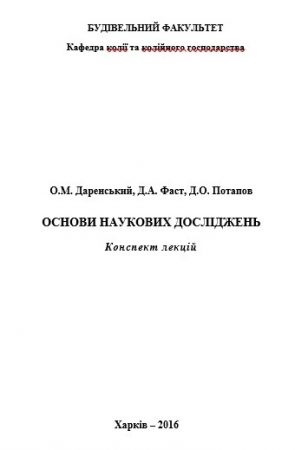 Basics of scientific research: a synopsis of lectures / Darenskyi O.M., Fast D.A., Potapov D.O. – Kharkiv: UkrSURT, 2016. – 73 p.
Basics of scientific research: a synopsis of lectures / Darenskyi O.M., Fast D.A., Potapov D.O. – Kharkiv: UkrSURT, 2016. – 73 p.
The synopsis of lectures consider general information about science and the organization of scientific research; existing methods and models of theoretical and experimental research; statistical methods of measuring measurements in experimental studies and checking the reliability of experimental data; methods of selection of empirical formulas; analysis of theoretical and experimental research, formulation of conclusions and proposals, preparation of a report and preparation of scientific materials for publication. The synopsis of lectures are intended for students of the specialty 273 – “Railway transport” and the educational program – “Railway structures and track facilities” studying the course “Basics of scientific research” in full-time and part-time forms of education.
 Railway track design / compilers: V. P. Shramenko, D. A. Fast, O. O. Ovchinnikov; department of track and track facilities. – Kharkiv: UkrSURT, 2019. – 42 p.
Railway track design / compilers: V. P. Shramenko, D. A. Fast, O. O. Ovchinnikov; department of track and track facilities. – Kharkiv: UkrSURT, 2019. – 42 p.
The methodical instructions cover the following issues: peculiarities of arrangement of running parts of rolling stock and rail track, standards and tolerances for its maintenance; calculation of track width in straight and curved track sections; determining the rise of the outer rail in the curved sections of the track; parameters of transitional curves, the number and order of deployment of shortened rails in curved sections of the track. These methodological instructions are intended for use in diploma and course design in the discipline “Railway track” by students of all forms of education in the specialty “Railway transport” of the educational programs “Management of the track complex of railways, urban and industrial transport” and “Railway structures and track facilities”.




